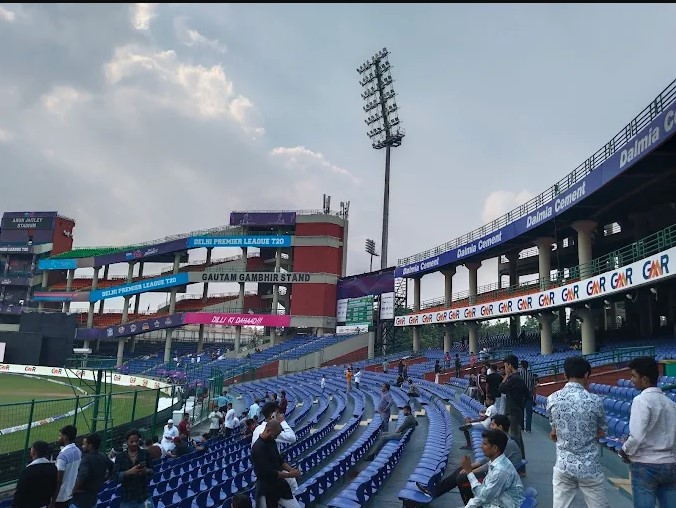Feroz Shah Kotla Cricket Ground: Feroz Shah Kotla Ground, now officially known as the Arun Jaitley Stadium, is one of India’s oldest and most iconic cricket venues. Located in Delhi, this ground has witnessed numerous memorable cricketing moments, from record-breaking innings to historic wins. While fans usually focus on the players and performances, another vital yet often overlooked aspect of cricket grounds is the boundary rope—specifically, its length and placement.
Table of Contents
Understanding the Boundary Rope
In cricket, the boundary rope defines the outermost edge of the playing field. When the ball crosses this rope, it’s deemed a boundary—four runs if it bounces before crossing, six if it crosses on the full. The length of the boundary rope directly affects gameplay strategies and player decisions, especially for batsmen and fielders.
According to International Cricket Council (ICC) regulations, the minimum distance from the center of the pitch to the boundary should be 59.43 meters (65 yards), and the maximum is 82.29 meters (90 yards). However, due to space constraints, especially in older stadiums like Feroz Shah Kotla, the boundary length may vary in different directions.
Boundary Dimensions at Feroz Shah Kotla
Though the exact measurements may vary slightly depending on pitch position and temporary adjustments, the typical boundary lengths at Feroz Shah Kotla (Arun Jaitley Stadium) are as follows:
| Direction | Approximate Distance (Meters) | Notes |
|---|---|---|
| Straight (North-South) | 70 – 75 | Slight variations with pitch rotation |
| Square (East-West) | 65 – 67 | Shorter than straight boundaries |
| Fine Leg / Third Man | 60 – 62 | Usually among the shortest boundaries |
| Deep Midwicket / Cover | 68 – 72 | Moderate distance, depends on setup |
These figures indicate that while the straight boundaries are relatively standard, the square boundaries are notably shorter, which can be advantageous for players adept at horizontal-bat shots like cuts and pulls.
Historical Context and Changes
Feroz Shah Kotla, established in 1883, wasn’t initially designed to meet modern international dimensions. Over the decades, with renovations and reconstructions, the stadium has evolved to accommodate contemporary standards. The most significant updates occurred in the 2000s and again around 2019 when the ground was renamed after Arun Jaitley.
Older matches featured boundary ropes closer to the pitch—sometimes around 60 meters all around, significantly favoring batsmen. However, post-2010, as part of global efforts to maintain fairness between bat and ball, the ropes were pushed back to align with ICC norms.
Impact on the Game
1. Batting Strategies
Shorter boundaries at Kotla, especially square of the wicket, have made it a batsman-friendly venue. Players often target the shorter sides, and spinners tend to be more cautious, altering their lengths to reduce scoring opportunities.
2. Bowling Considerations
Bowlers, especially fast bowlers, may avoid bowling wide lines that batsmen can exploit toward shorter square boundaries. Spinners tend to flight the ball less and rely more on flatter deliveries to prevent lofted shots clearing the rope.
3. Field Placements
Captains strategically adjust fielders to protect shorter zones. Deep square leg and deep point often come into play at Kotla, particularly during limited-overs formats like ODIs and T20s.
Comparisons with Other Grounds
Let’s compare Feroz Shah Kotla’s boundary sizes with some other major Indian stadiums:
| Stadium | Avg. Straight Boundary (m) | Avg. Square Boundary (m) |
|---|---|---|
| Arun Jaitley Stadium | 72 | 66 |
| Eden Gardens, Kolkata | 75 | 69 |
| Wankhede Stadium, Mumbai | 70 | 64 |
| M. Chinnaswamy, Bengaluru | 68 | 63 |
| Narendra Modi Stadium | 78 | 70 |
Challenges and Criticism
Despite its upgrades, Kotla has faced criticism regarding uneven boundary sizes. In some matches, there’s been a noticeable disparity of over 10 meters between opposite sides. Such inconsistencies can skew match balance, particularly in T20 games where every meter counts. Moreover, replays have occasionally shown ropes pulled inward to accommodate advertising boards or safety concerns, sparking controversy over fairness.
Future Developments
The Delhi & District Cricket Association (DDCA) has announced intentions to further modernize the stadium. Upcoming changes may include:
- Standardizing boundary dimensions closer to the ICC maximum to support bowlers.
- Improving field drainage and turf conditions.
- Enhancing spectator facilities without compromising ground size.
The boundary rope at Feroz Shah Kotla is not just a peripheral element—it actively shapes the dynamics of cricket matches played there. While not the longest in the country, its variable distances add a unique flavor to the venue, influencing tactics, scoring patterns, and player performance. With continuous modernization and adherence to international standards, the boundary lengths at Kotla aim to ensure a balanced contest between bat and ball—upholding the rich legacy of this storied cricket ground.


